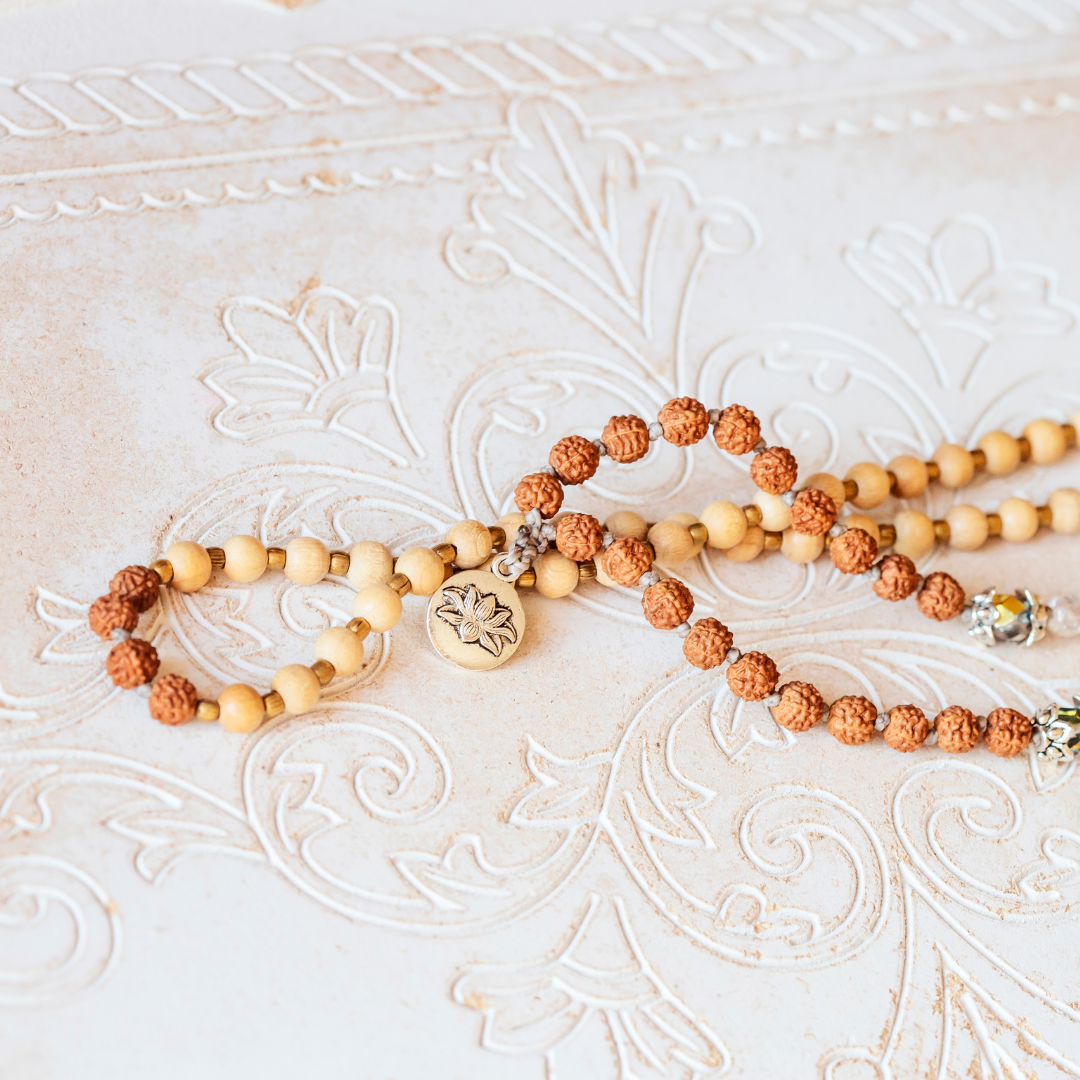How to Use Your Mala Beads
•Posted on March 22 2019

If you are living a busy life, but still trying to find balance in your life – meditation is the key. Speaking of which, did you know that one of the most common tools used during meditation are Mala Beads? We bet you have seen a lot of people use them during meditation, but do you know why? Read to learn about the magic of Mala Beads:

What are Mala Beads?
Mala Beads are one of the oldest tools used for meditation and are commonly used in various spiritual traditions, particularly in Hinduism and Buddhism. Although the beads can be made from all sorts of materials, and the number of beads vary, the most common malas are made of Rudraksha, Gemstones or Sandlewood and contain 27 or 108 beads.
In Hinduism, mala beads are known as "japa mala" and are used to chant mantras, recite prayers, and perform puja (worship). They are often made of Tulsi wood or Rudraksha seeds and have 108 beads, which represent the 108 names of God. In Buddhism, mala beads are called "prayer beads" or "Buddhist rosary" and are used to count repetitions of mantras or prayers. They are typically made of wood, bone, or seeds and can have 108 or 27 beads. In Jainism, mala beads are used to recite mantras and prayers as well as to count the number of times a person has performed certain rituals or penances. They are often made of tulsi wood, sandalwood, or rudraksha seeds. In Sikhism, mala beads are called "mala" or "simmal" and are used to recite the Sikh Mool Mantar. They are typically made of wooden beads and have 108 beads.
As you can see 108 is particularly important in some traditions and is common for a mala. According to some sources, the 1 in represents the universe, 0 represent emptiness, detachment, as well as humility and humbleness which are all very important values when it comes to spirituality, while the 8 represents infinity. According to others, 108 is considered a sacred number because, in Vedic culture, 108 represents the planets, revolving around the sun, and the average distance of the Sun and the Moon to earth is 108 times their diameter.
On the other hand some cultures use 27 beads, because number 27 has as much spiritual significance in many traditions as does 108. In Vedic astrology, there are 27 lunar mansions or nakshatras and in numerology, 27 is considered a powerful number that represents spiritual evolution and growth. In the Advaita Vedanta tradition, malas with 27 beads are more prevalent while 108 are more common in Tibetan Buddhism.
So, is it better for you to use a mala with 27 beads or 108 beads?
The choice of bead count can depend on the cultural or regional context of the practice but regardless of the reason, the use of a mala with no matter the amount of beads still allows for a meditative practice that promotes focus and mindfulness. This is especially true if you have recently started meditating or are having trouble with your meditative practice.
What Types of Mala Beads Are there?
Mala beads can be made from a wide range of materials, depending on the tradition and purpose for which they are used. However, some of the most popular mala beads are made of the following materials:
-
Rudraksha Seeds: Rudraksha seeds are believed to have healing properties and are commonly used in Hinduism and Buddhism. They are said to help balance the chakras and promote spiritual growth.
-
Sandalwood: Sandalwood is a fragrant wood that is often used in spiritual practices. Sandalwood malas are believed to promote relaxation and calmness.
-
Gemstones: Mala beads made of various gemstones are becoming increasingly popular. Different gemstones are believed to have different healing properties and can be chosen based on their energetic properties. For example, amethyst is said to promote clarity and calmness, while rose quartz is associated with love and compassion. And, Lava is fantastic for grounding.
-
Lotus Seed: Lotus seeds are considered a symbol of spiritual enlightenment in Buddhism. Lotus seed malas are said to promote spiritual growth and purity of the mind.
-
Bodhi Seed: Bodhi seeds are the seeds of the Bodhi tree, which is the tree under which the Buddha is said to have attained enlightenment. Bodhi seed malas are believed to promote spiritual growth and the attainment of enlightenment.
Overall, the type of mala you choose is totally up to you! You can use your intention or intuition as a guide.
How to use Mala Beads?
Using Mala Beads is simple, yet very effective. Plus, the coolest part is after you’ve charged your mala, you get to wear your intentions and their positive energy.
Here's a quick guide to using your mala.
-
Begin by finding a comfortable seated position and holding the mala beads in your right hand, using your thumb and middle finger to move the beads.
-
Start at the bead next to the guru bead, the larger bead that signifies the beginning and end of your meditation.
-
For each mantra, intention, affirmation or breath, move your thumb over one bead while reciting the chosen mantra or prayer.
-
Continue this process until you have gone around the entire mala, ending at the guru bead.
-
If you wish to continue meditating, simply turn the mala around and begin again, without passing over the guru bead.
In addition to meditation, mala beads can also be worn as jewelry or carried as a reminder of your spiritual practice throughout the day.
Where to buy Mala Beads?
Here! :) Check out our favorites below:
Comments
0 Comments
Leave a Comment